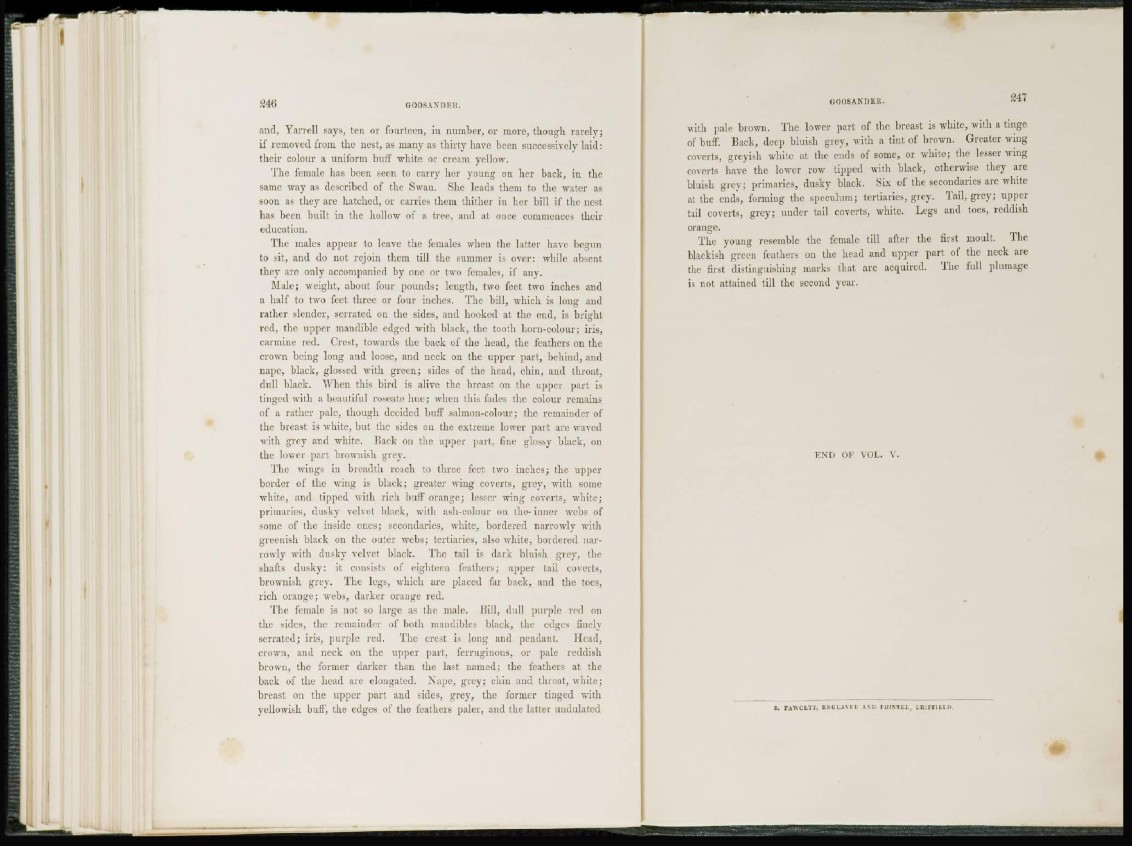
846 GOOSANDER.
and, Yarrell says, ten or fourteen, in number, or more, though rarely;
if removed from the nest, as many as thirty have been successively laid:
their colour a uniform buff white or cream yellow.
The female has been seen to carry her young on her back, in the
same way as described of the Swan. She leads them to the water as
soon as they are hatched, or carries them thither in her bill if the nest
has been built in the hollow of a tree, and at once commences their
education.
The males appear to leave the females when the latter have begun
to sit, and do not rejoin them till the summer is over: while absent
they are only accompanied by one or two females, if any.
Male; weight, about four pounds; length, two feet two inches and
a half to two feet three or four inches. The bill, which is long and
rather slender, serrated on the sides, and hooked at the end, is bright
red, the upper mandible edged with black, the tooth horn-colour; iris,
carmine red. Crest, towards the back of the head, the feathers on the
crown being long and loose, and neck on the upper part, behind, and
nape, black, glossed with green; sides of the head, chin, and throat,
dull black. When this bird is alive the breast on the upper part is
tinged with a beautiful roseate h u e ; when this fades the colour remains
of a rather pale, though decided buff salmon-colour; the remainder of
the breast is white, but the sides on the extreme lower part are waved
with grey and white. Back on the upper part, fine glossy black, on
the lower part brownish grey.
The wings in breadth reach to three feet two inches; the upper
border of the wing is black; greater wing coverts, grey, with some
wdiite, and tipped with rich buff orange; lesser wing coverts, white;
primaries, dusky velvet black, with ash-colour on the- inner webs of
some of the inside ones; secondaries, white, bordered narrowly with
greenish black on the outer webs; tertiaries, also wddte, bordered narrowly
with dusky velvet black. The tail is dark bluish grey, the
shafts dusky: it consists of eighteen feathers; upper tail coverts,
brownish grey. The legs, which arc placed far back, and the toes,
rich orange; webs, darker orange red.
The female is not so large as the male. Bill, dull purrde red on
the sides, the remainder of both mandibles black, the edges finely
serrated; iris, purple red. The crest is long and pendant. Head,
crown, and neck on the upper part, ferruginous, or pale reddish
brown, the former darker than the last named; the feathers at the
back of the head are elongated. Nape, grey; chin and throat, white;
breast on the upper part and sides, grey, the former tinged with
yellowish buff, the edges of the feathers paler, and the latter undulated
GOOSANDER. 847
with pale brown. The lower part of the breast is white, with a tinge
of buff. Back, deep bluish grey, with a tint of brown. Greater wing
coverts, greyish white at the ends of some, or white; the lesser wing
coverts have the lower row tipped with black, otherwise they are
bluish grey; primaries, dusky black. Six of the secondaries arc white
at the ends, forming the speculum; tertiaries, grey. Tail, grey; upper
tail coverts, grey; under tail coverts, white. Legs and toes, reddish
orange.
The young resemble the female till after the first moult. The
blackish green feathers on the head and upper part of the neck arc
the first distinguishing marks that arc acquired. The full plumage
is not attained till the second year.
END OF VOL. V.
B. FAlVCH'l, KNOltAVHE AM) PUIS TEE, LB1FF1ELD.